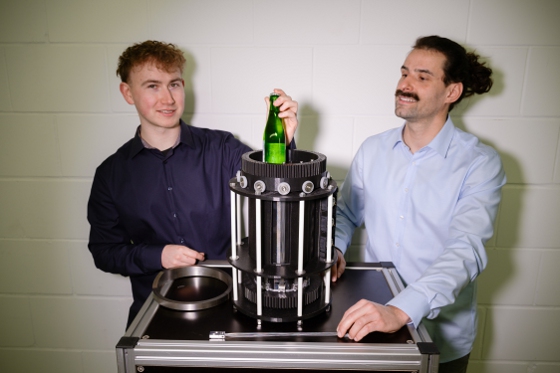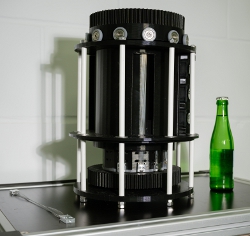 |
| April 16, 2024 | Volume 20 Issue 15 |
Designfax weekly eMagazine
Archives
Partners
Manufacturing Center
Product Spotlight
Modern Applications News
Metalworking Ideas For
Today's Job Shops
Tooling and Production
Strategies for large
metalworking plants
Elastocaloric cooling: 10x efficiency of today's AC or refrigeration systems
The world's first refrigerator that is cooled with artificial muscles only has room for one bottle, but it's an impressive working demonstrator of climate-friendly cooling and heating technology that is far more energy efficient than current methods. The mini fridge, which is cooled with artificial muscles made of nitinol, a nickel-titanium alloy, was created by researchers at Saarland University and the Center for Mechatronics and Automation Technology (ZeMa) in Germany to show how elastocalorics is becoming a viable solution for practical applications.

Student Nicolas Scherer (left) and PhD student Lukas Ehl are working on the new elastocaloric cooling system as part of the team led by professors Stefan Seelecke and Paul Motzki at Saarland University. The system does not use any traditional refrigerants. [Credit: © Oliver Dietze]
The new technology integrated into a small, compact refrigerator prototype, is based on an incredibly simple principle: heat is removed from a space by stretching wires and releasing them again. Known as "artificial muscles," the shape-memory wires made of super-elastic nitinol absorb heat in the cooling chamber and release it to the outer environment.
"Our elastocaloric process enables us to achieve temperature differences of around 20 degrees Celsius without using climate-damaging refrigerants in a far more energy-efficient manner than today's conventional technologies," explains Professor Stefan Seelecke, who conducts research at Saarland and ZeMa.
The researchers say the efficiency of elastocaloric materials is more than 10 times that of today's air conditioning (AC) systems or refrigerators. The U.S. Department of Energy and the EU Commission have declared the cooling technology developed in Saarbrucken to be the most promising alternative to existing processes. It can extract heat from much larger spaces than the small cooling chamber that the engineers are using to demonstrate elastocalorics at the upcoming giant Hannover Messe industrial trade show in Hanover, Germany (April 22-26). It can also supply heat to much larger spaces. Heat transfer via the superelastic wires also works for heating applications. In view of climate change, energy shortages, and the growing demand for cooling and heating, the process represents a highly promising solution for the future.

Credit: © Oliver Dietze]
To transport heat, the researchers use the special "superpower" of the artificial muscles made of nitinol: shape memory. Wires made of this alloy remember their original shape and revert to it after they have been deformed or stretched. Like muscles flexing, they can become long and then short again, and are also able to tense and relax. The reason for this lies deep inside the nitinol, which has two crystal lattices -- two phases that can transform into each other.
Unlike water, whose phases are solid, liquid, and gaseous, the two phases of nitinol are both solid. During these phase transitions of the crystalline structure, the wires absorb heat and release it again. "The shape-memory material releases heat when it is stretched in a superelastic state and absorbs heat when it is released," says Professor Paul Motzki, who holds a cross-institutional professorship at Saarland University and ZeMa, where he heads the Smart Material Systems research group. The effect is intensified if numerous wires are bundled together; due to their larger surface area, they absorb and release more heat.
Although the principle may at first seem very simple, the research questions that need to be addressed to construct a cooling circuit are highly complex. In the mini fridge the research team will be presenting in Hanover, a specially designed, patented cam drive continuously rotates bundles of 200 micron-thin nitinol wires around a circular cooling chamber.
"As they move in a circle, they are mechanically loaded on one side, i.e. stretched, and unloaded on the other," explains PhD student Lukas Ehl, who is working on the cooling system. Air is channeled past the rotating bundles into the cooling chamber, where the wires are unloaded and absorb heat from the air. The air then circulates continuously around unloaded wires in the cooling chamber. As they continue to rotate, the wires transport heat out of the cooling chamber and release it when stretched outside the cooling chamber. "The cooling chamber cools to around 10 to 12 degrees Celsius [50 to 53.6 F] using this method," says student Nicolas Scherer, who is conducting research as part of the project for his Master's thesis.
VIDEO: Elastocaloric cooling/heating machine: The solid-state "heat pump" of tomorrow. [Credit: mateligent GmbH]
The engineers in Saarbrucken are researching how the drive keeps the wires permanently in motion, what the air flows look like, in what way the processes are most efficient, how many wires they need to bundle, how strongly they should ideally be stretched for a certain cooling level, and much more. They have also developed software that enables them to adjust the heating and cooling technology for different applications and to simulate and plan cooling systems. Additionally, they are researching the entire cycle from material production and recycling through to production.
Refrigerators are just the start. "We want to leverage the innovative potential of elastocalorics in a wide range of applications, such as industrial cooling, electric vehicle cooling to advance e-mobility, and also household appliances," says Motzki.
The new technology is the result of over a decade of research in several million-euro research projects and multiple award-winning doctoral dissertation projects. Project funding has come in part from the EU and the German Research Foundation (DFG). The Federal Ministry of Education and Research is investing more than 17 million euros in the DEPART!Saar project, in which the researchers are collaborating with other research institutions and industrial partners. The aim is to give rise to new technology transfer formats and accelerate the path to market. In several research projects and doctoral dissertation projects, the engineers have also developed a cooling and heating demonstrator that runs continuously and shows how elastocalorics can cool and heat air.
At the Hannover Messe, the Saarbrucken-based experts for smart material systems will also be demonstrating the versatility of their shape-memory tech in the form of smart miniature drives, energy-efficient robotic grippers, and soft robotic arms in the shape of elephant trunks.
Source: Saarland University
Published April 2024
Rate this article
View our terms of use and privacy policy
